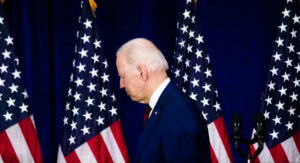Emmanuel Macron’s call for Europe to reduce its dependency on the United States and develop its own “strategic autonomy” caused a transatlantic tantrum. The Atlanticist establishment, in the US as much as in Europe, responded in a typically unrestrained fashion — and, in doing so, missed something crucial: Macron’s words revealed less about the state of Euro-American relations than they did about intra-European relations.
Very simply, the “Europe” Macron speaks of no longer exists, if it ever did. On paper, almost the entire continent is united under one supranational flag — that of the European Union. But that is more fractured than ever. On top of the economic and cultural divides that have always plagued the bloc, the war in Ukraine has caused a massive fault line to re-emerge along the borders of the Iron Curtain. The East-West divide is back with a vengeance.
This was underscored by the reaction to Macron’s remarks. On the one hand, Charles Michel, the Belgian President of the European Council, implied that the French president’s position reflects the views of several Western European leaders, including in Germany. On the other, Mateusz Morawiecki, the prime minister of Poland, spoke for most Central and Eastern European (CEE) countries when he stated: “The alliance with the United States is the absolute foundation of our security… Instead of building strategic autonomy from the US, I propose a strategic partnership with the US.” This isn’t a tactical or even a strategic disagreement; these are two existentially dichotomous visions.
Perhaps we shouldn’t be surprised. The East-West divide has been one of Europe’s defining geographical and political paradigms for centuries. The end of the Cold War and, then, the CEE countries’ accession to the EU just over a decade later were both heralded as the post-Communist countries’ much-awaited “return to Europe”. It was widely believed that the EU’s universalist project would smooth out any major social and cultural differences between Western and Central-Eastern Europe — meaning that the latter would slowly become more like the former. Such a hubristic (and arguably imperialistic) project was bound to fail; indeed, tensions and contradictions quickly became apparent between the two Europes.
One early topic of disagreement was, inevitably, Russia. Since they emerged from Soviet occupation, several CEE states, especially those on or close to the border with Russia, have remained suspicious of Moscow’s geostrategic intentions. By contrast, Western European nations, with Germany at the forefront, boosted economic ties with Russia, especially in the field of energy. Some even envisaged building an integrated Eurasian geopolitical bloc theoretically stretching from Lisbon to Vladivostok. From a Central-Eastern European perspective this might have seemed crazy, but from a Western European perspective it made perfect sense, given the strong historical, cultural and even ideological ties (especially in those countries with once-powerful Communist parties) between Western Europe and Russia.
Over the years, America amplified these divisions. In 2003, for example, on the eve of the Iraq War, Donald Rumsfeld famously scorned France and Germany as the “old Europe”, which he contrasted with the vitality of the “new Europe” — the CEE states that were soon after included in Nato. “The centre of gravity is shifting to the East,” he said.
Several CEE countries — Poland in particular, for obvious reasons — also had historic grievances against Germany, and serious misgivings about the emergence of a potential Russo-German axis. This is why the Nord Stream project was almost unanimously opposed by CEE states. The East’s integration into the German value chain, considered one of the EU’s success stories, reinforced the region’s ambivalent relationship with Germany: while Central-Eastern Europe benefited from being part of Germany’s powerful “assembly chain”, it also reignited fears of EU-German economic imperialism (in this respect, many CEE countries were smart enough not to join the eurozone).
The most pronounced East-West cleavages, however, emerged along cultural lines, rather than economic or geopolitical ones. In 1993, Samuel Huntington was the first to predict that the Iron Curtain, which had politically and ideologically divided Europe for half a century, would be replaced by “the Velvet Curtain” of culture. Western Europe, he wrote, has been predominantly Catholic, Protestant, and Anglican, while Eastern Europe has been predominantly Orthodox — and this has led to the emergence of very different social values. Where Western Europe developed a more individualistic and secular culture that values “liberal” rights and freedoms, Eastern Europe has historically had a more collectivist and family-oriented culture, with a greater emphasis on family, community, social relationships and religion. Following the Cold War, the CEE states strove to be more politically and socially aligned with the West. But key differences remained on issues such as immigration, abortion and gay rights, as well as over national sovereignty.
In recent years, the EU’s aggressive attempts to impose its integrationist and socially progressive values across Central and Eastern Europe have led to an increasingly assertive pushback. The result has been a souring of EU-CEE relations, and increased coordination among CEE states — such as with the Visegrád Group and the Three Seas Initiative — to boost their autonomy.
Until recently, the turn towards “illiberal” or “post-liberal” democracy in various CEE countries — most notably Hungary and Poland — was described as one of the greatest threats to the EU, with those nations branded as the bloc’s bêtes noires. But Russia’s invasion of Ukraine has changed this. Overnight, Poland, Slovakia, Hungary and Romania became the EU’s direct border with a war zone. The invasion also enhanced the geostrategic importance of countries that border Russia or Russian-controlled Belarus (Lithuania, Latvia, Estonia and Finland), as well as those which overlook the strategically crucial Northern Sea Route (Norway and Sweden). In other words, the conflict has dramatically shifted Europe’s geopolitical balance of power from the West to the East (and partly to the North). These countries have been receiving unprecedented international attention, funding and, most important, defence equipment.
The number of US soldiers in Central-Eastern Europe, for instance, has more than doubled to over 14,000. Most of them — around 10,000 — are in Poland, which is also the country that has most benefited from these developments. As the biggest and richest nation in the CEE (and the sixth-largest economy in the EU), it has long aspired to a leading role in the central and north-eastern quadrant, capable of counterbalancing both Russia and the Franco-German axis. The conflict has given this project a huge impetus.
Poland, which has always been staunchly pro-US and pro-Nato, already had one of the most formidable armies in Europe before the conflict. And in the past year, it has launched a massive rearmament plan to build a 300,000-strong high-tech army and transform the country into Europe’s military superpower. Crucially, this strategy is aimed at Germany (and the EU) as much as it is at Russia: last August, Polish Foreign Minister Zbigniew Rau likened “Russian imperialism” to “imperial practices within the EU”, particularly in Germany.
Meanwhile, Poland has welcomed millions of Ukrainian refugees and given Ukraine hundreds of tanks and other weapons systems (including some MiG-29 fighter jets). Following America’s decision to make Poland a permanent base for the US Army’s V Corps, which commands the eastern flank’s US land forces, the country has, in effect, become the logistical hub of Nato’s war efforts in Ukraine. As a result, Poland’s self-perception as an aspiring regional power is also becoming more pronounced. Last month, the Polish Ambassador to France suggested that Poland might “enter the conflict” if necessary. And there is even a lively debate in Poland as to whether it should merge with Ukraine into a federal or confederal state.
Poland’s ambition clearly aligns with America’s aim to shift Europe’s balance of power towards the “new Europe”, which explains why the US has been quick to lend it considerable support, even at the cost of sowing further divisions on the continent. “Poland has become our most important partner in continental Europe,” a senior US Army official in Europe told Politico. Significantly, after visiting Ukraine last month, Biden made only one other additional stop on his European trip: Warsaw.
Whether this will translate into a long-term shift in political power to the East will also depend on economic dynamics. Western Europe continues to hold primacy on this front, but its economies, particularly Germany’s, have suffered a serious blow as a result of the conflict and related sanctions. Much will hang on whether the re-militarisation of Europe becomes a permanent feature in the coming years, in which case the CEE and Baltic countries — which are currently investing the most in their defence and technological sectors — would benefit economically as well, acquiring a central role in the EU’s long-term defence industrial policy.
Another factor will be the growing rifts caused by the conflict in the CEE. Hungary, formerly Poland’s closest ally in the Visegrád Group, has refused to send weapons to Ukraine, and has maintained close economic ties with Moscow, including continuing to import Russian energy on favourable terms. Viktor Orbán has explicitly sided with Macron on the question of Euro-American relations. “At present, the EU is uncritically adopting the US position wholesale, with US interests simply being presented as European interests,” Orbán said last October. “This is precisely why today Europe is one of the losers in this war and the US is one of the winners.”
None of this, however, significantly alters the fact that the East-West divide in Europe is greater than it has been for decades — and will remain so for the foreseeable future. Ultimately, Western Europe has every interest in reducing its dependency on the US and Nato, reaching a diplomatic solution to the conflict and, as Macron argued, re-normalising security and economic relations with Russia. Central and Eastern Europe, on other hand, has every reason to be fearful of Russia and to favour tighter relations with the US and Nato.
It is, therefore, hard to see how the interests and aspirations of the two sub-blocs could ever be reconciled, especially in the context of EU politics. If countries such as France are serious about “strategic autonomy”, it appears they will have to go it alone.
Disclaimer
Some of the posts we share are controversial and we do not necessarily agree with them in the whole extend. Sometimes we agree with the content or part of it but we do not agree with the narration or language. Nevertheless we find them somehow interesting, valuable and/or informative or we share them, because we strongly believe in freedom of speech, free press and journalism. We strongly encourage you to have a critical approach to all the content, do your own research and analysis to build your own opinion.
We would be glad to have your feedback.
Source: UnHerd Read the original article here: https://unherd.com/



